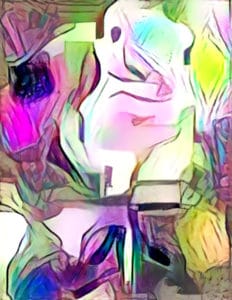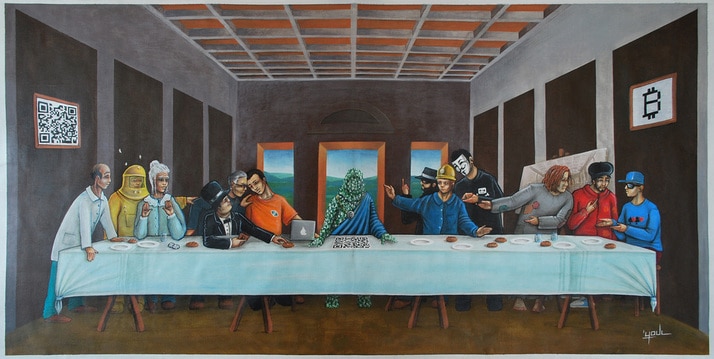Latest news about Bitcoin and all cryptocurrencies. Your daily crypto news habit.
Some people say that technology is a form of art. With the recent boom of the blockchain art market, this is looking to be more fact than fiction these days. From digital kittens and meme trading cards fetching prices of over $100,000 to artificial intelligence (AI) driven artwork, blockchain technology has officially entered the art world.
Blockchain art consists of more than just slapping a piece of art online, though. There are a few things you should know about this emerging market and how it’s changing art for the better.
People are Creating Blockchain Art
There are a few different methods artists are using to incorporate blockchain into their work. Some artists are creating pieces in which blockchain is the subject while others are actually using the technology in their creations.
Collectibles
Currently the most popular form of blockchain art, collectibles like CryptoKitties and Rare Pepe trading cards have garnered a cult-like following. These digital pieces of art are directly created, stored, and traded on blockchain platforms like Ethereum and Counterparty.
Like Beanie Babies, the rareness of each collectible is what drives its value and price. You can easily pick up collectible blockchain art for as little as $5, but some pieces have price tags of over $100,000.
Blockchain-driven Art

Current Scarab Experiment Artwork
Beyond collectibles, artists are finding other ways to utilize blockchain technology for their artwork. One example of this is the Scarab Experiment. The Scarab Experiment combines artificial intelligence (AI) with tokenized memberships to create one piece of art from the combined 1000 submissions of community members. Once you submit your art, you receive a tradeable Scarab token that gives you voting rights for what artwork the project includes.
Plantoid is a self-replicating “life form” also driven by AI and blockchain, specifically Bitcoin and Ethereum. It’s a robotic plant with a DNA structure on the Ethereum network that interacts with the people that donate to it. Once it receives enough Bitcoin donations, the Plantoid enters the “reproduction phase” in which it puts out a call for artists and designers to create another Plantoid. The person that gets the bid must create another Plantoid following the same DNA rules as the Plantoid before it. In return, the creator receives the Bitcoin donations from the original plant through a smart contract.
Blockchain-based Art
Although not built with blockchain, there are numerous works of art that use the technology as inspiration. Recently, the first-ever publically commissioned Bitcoin monument was erected in Kranj, Slovenia. Citizens of the city submitted ideas for the monument via Facebook, and officials chose Bitcoin because of the region’s ties with the industry.
Blockchain has also influenced Bitcoin graffiti art, renditions of Satoshi Nakamoto, and even the Last (Bitcoin) Supper.
You Can Track And Verify Art On The Blockchain
Perhaps more important than creating art is being able to verify that the art you purchase is authentic. The Fine Art Experts Institute (FAEI) in Geneva stated in 2014 that over 50% of the artwork that they examine are either forged or misattributed to the incorrect artists. With pieces in the fine arts market selling for tens or even hundreds of thousands of dollars, it’s important that you’re buying what you think you’re buying.
Similar to blockchain’s use in agriculture and supply chain, you can use the power of public immutability to maintain art’s integrity. To do so, some projects are working to tokenize art provenance. Blockchain art provenance is a method of proving the ownership of original creations via blockchain. It works like this:
- An artist creates a new piece and certifies it with a token on a blockchain.
- When you buy the artwork from the artist, they transfer the associated token to you.
- When you sell the piece, you transfer the token to the buyer.
- And so on, and so on.
The token transactions are stored publicly, so you, as a buyer, can easily track the entire history of ownership back to the artist. If the token doesn’t originate with the artist’s wallet, the artwork is a fake.
You can use this process for physical pieces of art as well as digital works. Because digital works are easily reproducible, associating them with tokens preserves their rarity which, in turn, retains their value.
Blockchain in Art Eliminates Middlemen…Once Again
As with most industries, the blockchain art market is best at making middlemen obsolete. Decentralized art galleries are popping up left and right giving most (if not all) of sale proceeds to the artists.
Curio Cards are GIFs and images tied to Ethereum in which artists receive 100% of their sales. Because the cards are on the blockchain, you, as an artist, can choose exactly how many you want to sell. There’s no need to worry about copying, forgery, or massive fees. This opens up a whole new world of monetization for digital artists.
Even with physical works of art, galleries are using blockchain. Maecenas is a decentralized platform that democratizes fine art. If you’d like to get involved with art investing but don’t have the bankroll to purchase a multi-thousand dollar piece, this platform is for you. On Maecenas, you can invest in a portion of artwork using the platform’s ART tokens. Additionally, to finance new pieces, galleries are able to list their artwork to Maecenas users at a fraction of the cost of what an auctioneer or loan would cost them.
Participate in the Blockchain Art Market
Whether you’re a collector, creator, or just a casual observer, art’s blockchain revolution probably affects you in some way. Even in this young industry, there are still plenty of ways to get involved and stretch your creative muscles.
Don’t let a lack of artistic ability stop you. Projects like Slothicorn, which provides a Universal Basic Income for all crypto art (including “GIFs”), give you the support you need when first starting out.
Who knows? You could just become the first meme-making millionaire.
The post Blockchain and Art: The Market is Here and What You Need to Know appeared first on CoinCentral.
Disclaimer
The views and opinions expressed in this article are solely those of the authors and do not reflect the views of Bitcoin Insider. Every investment and trading move involves risk - this is especially true for cryptocurrencies given their volatility. We strongly advise our readers to conduct their own research when making a decision.
